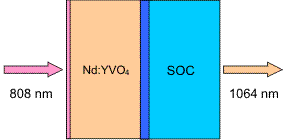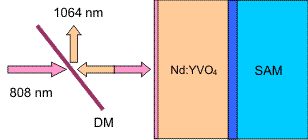> Energy band gap>
GaAs |
AlxGa1-xAs |
InxGa1-xAs
> Refractive index
> GaAs |
AlAs |
AlxGa1-xAs |
InxGa1-xAs
> Devices
> Bragg mirror |
SAM |
RSAM |
SA |
SANOS |
SOC |
Microchip |
PCA
> Device application
> Papers |
Patents |
FAQs

Passively Q-switched microchip laser
MCT- microchip in transmission
Construction:
- A Nd:YVO4 laser crystal is bonded with a saturable output coupler (SOC).
- The laser crystal is pumped with 808 nm cw light.
- The laser cavity length is mainly given by the crystal thickness.

MC- microchip in reflection
Construction:
- A Nd:YVO4 laser crystal is bonded with a saturable absorber mirror (SAM).
- The laser crystal is pumped with 808 nm cw light.
- A dichroitic mirror separates the 1064 output pulses..

• Working principle
Working principle
- Continuous pumping of the laser crystal results in increasing gain and luminescence.
- If the round trip gain in the microchip laser cavity increases above one then a laser pulse starts and the absorption of the saturable absorber decreases due to its saturation. This saturation increases the gain per round trip further.
- The resonator round trip time TR of the light in the laser cavity is very short. With a typical crystal thickness L = 200 µm and a refractive index ne = 2.17 the round trip time TR can be calculated to TR = 2*ne*L/c ~ 2.9 ps. Therefore the pulse intensity increases very fast. The slope of the increasing pulse train is determined by the modulation depth ΔR of the saturable absorber.
- With increasing pulse amplitude the stimulated emission increases. Therefore the decrease of the gain accelerates and overcomes the pump effect. If the round trip gain in case of the saturated absorber decreases below one then the laser stops.
- Because of continuous pumping after some time the gain is recovered and the laser starts again. This time between consecutive pulses decreases with increasing pump power. Therefore the pulse repatition rate is nearly proportional to the pump power.
- The onset of a pulse depends on the spontaneous emission. Therefore the repetition rate is not fixed, but fluctuates somewhat.
- If the laser cavity length L is short and the pump spot diameter small the laser works in single mode. See Applied Physics, Vol. B97, p.317, 2009 (pdf)
- The laser pulses are linear polarized parallel to the c-axis of the Nd:YVO4 laser crystal
• Pulse energy
Pulse energy EP
According to the well established formalism (Journal of the Optical Society of America B, Vol. 16, Issue 3, pp. 376-388, 1999) of passive Q-switched microchip laser the pulse energy Ep can be estimated as follows:

with
- Fsat,L - saturation fluence of the laser material
- A - pump spot area in the resonator
- ΔR - modulation depth of the SAM
- T - transmission of the output coupler
- Ans - non-saturable losses, mainly from SAM.
With typical values Fsat,L = 37.3 mJ/cm2, A = 1.3x10-5cm2 ( 40 µm spot diameter), ΔR = 0.1, T = 0.1, and loss Ans = 0.05 the pulse energy can be estimated to Ep ~ 32 nJ.
• Pulse repetition rate
Pulse repetition rate frep
The average output power Pav is proportional to the pump power. Therefore the repetition rate shows a linear behavior by changing the pump power according to:

with
- ηs - slope efficiency
- PP - pump power
- PP,th - pump power threshold
- EP - pule energy
By changing the pump power PP repetition rates between 100 kHz and 2 MHz can be realized with a nearly constant pulse energy EP. Because the pulses start with spontaneous emission, the repetition rate shows a time jitter of about 1 %, increasing with decreasing pump power and rate.
• Pulse duration
Pulse duration tP
The pulse duration tP in passive Q-switched lasers can be estimated by:

with
- TR - resonator round trip time
- ΔR - modulation depth of the SAM
- n - refractive index of the resonator material
- L - resonator length
- c - speed of light in vacuum.
With a short laser crystal length L = 0.2 mm, refractive index n ~ 2.17, and a SAM modulation depth of ΔR = 0.1 the pulse duration is ~ 100 ps.